Season and Nitrogen Fertilization Effects on Yield and Physicochemical Attributes of Strawberry under Subtropical Climate Conditions
Abstract
:1. Introduction
2. Materials and Methods
2.1. Experiment Site
2.2. Plant Material
2.3. Field Preparation and Crop Management
2.4. Fertilization Treatments
2.5. Yield
2.6. Fruit Quality Analysis
2.7. Weather
2.8. Experimental Design and Statistical Analysis
3. Results
3.1. Marketable Yields
3.2. Average Berry Weight
3.3. Linear Correlations between Berry Size and Yield or Berry Number and Yield
3.4. Ratio of Yield and Total Fertilizer N Input
3.5. Fruit Color and Texture
3.6. Chemical and Sensory Attributes
4. Discussion
4.1. Yield Increases by High Early-Season N Fertilization Are Long-Term and Consistent
4.2. Optimum Early-Season N Fertilization Can Increase Yield with a Minimal Risk of Increasing N Loss and Environmental Pollution Risks
4.3. Season Has Greater Effects on Fruit Quality than Early-Season N Fertilization
4.4. Impacts of Environmental Conditions on Physicochemical Profiles
5. Conclusions
Author Contributions
Funding
Institutional Review Board Statement
Informed Consent Statement
Data Availability Statement
Acknowledgments
Conflicts of Interest
References
- Giampieri, F.; Tulipani, S.; Alvarez-Suarez, J.M.; Quiles, J.L.; Mezzetti, B.; Battino, M. The strawberry: Composition, nutritional quality, and impact on human health. Nutrition 2012, 28, 9–19. [Google Scholar] [CrossRef] [PubMed]
- Kelly, K.; Whitaker, V.M.; Nunes, M.C.D.N. Physicochemical characterization and postharvest performance of the new Sensation® ‘Florida127’ strawberry compared to commercial standards. Sci. Hortic. 2016, 211, 283–294. [Google Scholar] [CrossRef]
- Di Vittori, L.; Mazzoni, L.; Battino, M.; Mezzetti, B. Pre-harvest factors influencing the quality of berries. Sci. Hortic. 2018, 233, 310–322. [Google Scholar] [CrossRef]
- Trejo-Téllez, L.I.; Gómez-Merino, F.C. Nutrient management in strawberry: Effects on yield, quality and plant health. In Strawberries: Cultivation, Antioxidant Properties and Health Benefits; Malone, N., Ed.; Nova Science Publishers, Inc.: Hauppauge, NY, USA, 2014; pp. 239–267. [Google Scholar]
- Agüero, J.J.; Salazar, S.M.; Kirschbaum, D.S.; Jerez, E.F. Factors affecting fruit quality in strawberries grown in a subtropical environment. Int. J. Fruit Sci. 2015, 15, 223–234. [Google Scholar] [CrossRef]
- Nestby, R.; Lieten, F.; Pivot, D.; Lacroix, C.R.; Tagliavini, M. Influence of mineral nutrients on strawberry fruit quality and their accumulation in plant organs. Int. J. Fruit Sci. 2005, 5, 139–156. [Google Scholar] [CrossRef]
- Cardeñosa, V.; Medrano, E.; Lorenzo, P.; Sánchez-Guerrero, M.C.; Cuevas, F.; Pradas, I.; Moreno-Rojas, J.M. Effects of salinity and nitrogen supply on the quality and health-related compounds of strawberry fruits (Fragaria ×ananassa cv. Primoris). J. Sci. Food Agric. 2015, 95, 2924–2930. [Google Scholar] [CrossRef]
- Cayo, Y.P.; Sargent, S.A.; do Nascimento Nunes, C.; Whitaker, V. Composition of commercial strawberry cultivars and advanced selections as affected by season, harvest, and postharvest storage. Hortscience 2016, 51, 1134–1143. [Google Scholar] [CrossRef] [Green Version]
- Abountiolas, M.; Kelly, K.; Yagiz, Y.; Li, Z.; Mahnken, G.; Borejsza-Wysocki, W.; Marshall, M.; Sims, C.A.; Peres, N.; do Nascimento Nunes, M.C. Sensory quality, physicochemical attributes, polyphenol profiles, and residual fungicides in strawberries from different disease-control treatments. J. Agric. Food Chem. 2018, 66, 6986–6996. [Google Scholar] [CrossRef]
- Chandramohan Reddy, G.; Goyal, R.K. Growth, yield and quality of strawberry as affected by fertilizer N rate and biofertilizers inoculation under greenhouse conditions. J. Plant Nutr. 2021, 44, 46–58. [Google Scholar] [CrossRef]
- Miner, G.S.; Poling, E.B.; Carroll, D.E.; Nelson, L.A.; Campbell, C.R. Influence of fall nitrogen and spring nitrogen–potassium applications on yield and fruit quality of ‘Chandler’ strawberry. J. Am. Soc. Hortic. Sci. 1997, 122, 290–295. [Google Scholar] [CrossRef] [Green Version]
- Taiz, L.; Zeiger, E. Plant Physiology, 5th ed.; Sinauer Associates: Sunderland, MA, USA, 2010. [Google Scholar]
- Agehara, S. Characterizing early-season nitrogen fertilization rate effects on growth, yield, and quality of strawberry. Agronomy 2021, 11, 905. [Google Scholar] [CrossRef]
- Shahzad, S.; Silvasy, T.; Agehara, S. Optimization of early-season nitrogen fertilization program for new strawberry cultivar’Florida Beauty’. Proc. Fla. State Hortic. Soc. 2018, 131, 103–105. [Google Scholar]
- Wu, F.; Guan, Z.; Whitaker, V. Optimizing yield distribution under biological and economic constraints: Florida strawberries as a model for perishable commodities. Agric. Syst. 2015, 141, 113–120. [Google Scholar] [CrossRef]
- Whitaker, V.M.; Chandler, C.K.; Peres, N.A. ‘Florida Radiance’ strawberry. EDIS 2013, 6, 1–4. [Google Scholar] [CrossRef]
- Samtani, J.B.; Rom, C.R.; Friedrich, H.; Fennimore, S.A.; Finn, C.E.; Petran, A.; Wallace, R.W.; Pritts, M.P.; Fernandez, G.; Chase, C.A.; et al. The status and future of the strawberry industry in the United States. HortTechnology 2019, 29, 11–24. [Google Scholar] [CrossRef] [Green Version]
- Torres-Quezada, E.; Zotarelli, L.; Whitaker, V.; Agehara, S. Methods for strawberry transplant establishment in Florida. EDIS 2020, 6, 1–4. [Google Scholar] [CrossRef]
- Whitaker, V.M.; Boyd, N.S.; Peres, N.A.; Desaeger, J.; Lahiri, S. 2020–2021 Vegetable production handbook: Chapter 16. Strawberry production. EDIS 2020, 1–24. [Google Scholar] [CrossRef]
- U.S. Department of Agriculture. United States Standards for Grades of Strawberries. Available online: https://www.ams.usda.gov/sites/default/files/media/Strawberry_Standard%5B1%5D.pdf (accessed on 28 April 2019).
- Lassaletta, L.; Billen, G.; Grizzetti, B.; Anglade, J.; Garnier, J. 50 year trends in nitrogen use efficiency of world cropping systems: The relationship between yield and nitrogen input to cropland. Environ. Res. Lett. 2014, 9, 105011. [Google Scholar] [CrossRef]
- Whitaker, V.M.; Chandler, C.K.; Santos, B.M.; Peres, N.; do Nascimento Nunes, M.C.; Plotto, A.; Sims, C.A. Winterstar™(‘FL 05-107’) strawberry. HortScience 2012, 47, 296–298. [Google Scholar] [CrossRef] [Green Version]
- Nunes, M.C.N.; Brecht, J.K.; Morais, A.M.M.B.; Sargent, S.A. Physical and chemical quality characteristics of strawberries after storage are reduced by a short delay to cooling. Postharvest Biol. Technol. 1995, 6, 17–28. [Google Scholar] [CrossRef]
- Nunes, M.C.N.; Brecht, J.K.; Morais, A.M.B.; Sargent, S.A. Possible influences of water loss and polyphenol oxidase activity on anthocyanin content and discoloration in fresh ripe strawberry (cv. Oso Grande) during storage at 1 °C. J. Food Sci. 2005, 70, S79–S84. [Google Scholar] [CrossRef]
- Jiang, C.; Lu, D.; Zu, C.; Zhou, J.; Wang, H. Root-zone fertilization improves crop yields and minimizes nitrogen loss in summer maize in China. Sci. Rep. 2018, 8, 15139. [Google Scholar] [CrossRef] [PubMed] [Green Version]
- Wang, Z.-H.; Li, S.-X. Chapter Three—Nitrate N loss by leaching and surface runoff in agricultural land: A global issue (a review). Adv. Agron. 2019, 156, 159–217. [Google Scholar]
- Hanson, H.C. Comparison of root and top development in varieties of strawberry. Am. J. Bot. 1931, 18, 658–673. [Google Scholar] [CrossRef]
- Wolfe, A.H.; Patz, J.A. Reactive nitrogen and human health: Acute and long-term implications. Ambio 2002, 31, 120–125. [Google Scholar] [CrossRef] [PubMed]
- Wold, A.; Opstad, N. Fruit quality in strawberry (Fragaria ×ananassa Duch. cv. Korona) at three times during the season and with two fertilizer strategies. J. Appl. Bot. Food Qual. 2007, 81, 36–40. [Google Scholar]
- Ojeda-Real, L.A.; Lobit, P.; Cárdenas-Navarro, R.; Grageda-Cabrera, O.; Farías-Rodríguez, R.; Valencia-Cantero, E.; Macías-Rodríguez, L. Effect of nitrogen fertilization on quality markers of strawberry (Fragaria ×ananassa Duch. cv. Aromas). J. Sci. Food Agric. 2009, 89, 935–939. [Google Scholar] [CrossRef]
- Nunes, M.C.N.; Brecht, J.K.; Morais, A.M.; Sargent, S.A. Physicochemical changes during strawberry development in the field compared with those that occur in harvested fruit during storage. J. Sci. Food Agric. 2006, 86, 180–190. [Google Scholar] [CrossRef]
- Dixon, R.A.; Paiva, N.L. Stress-induced phenylpropanoid metabolism. Plant Cell 1995, 7, 1085–1097. [Google Scholar] [CrossRef]
- Cervantes, L.; Ariza, M.T.; Gómez-Mora, J.A.; Miranda, L.; Medina, J.J.; Soria, C.; Martínez-Ferri, E. Light exposure affects fruit quality in different strawberry cultivars under field conditions. Sci. Hortic. 2019, 252, 291–297. [Google Scholar] [CrossRef]
- Fan, Z.; Plotto, A.; Bai, J.; Whitaker, V.M. Volatiles influencing sensory attributes and bayesian modeling of the soluble solids–sweetness relationship in strawberry. Front. Plant Sci. 2021, 12, 252. [Google Scholar] [CrossRef] [PubMed]
- Choi, H.G.; Moon, B.Y.; Kang, N.J. Correlation between strawberry (Fragaria ananassa Duch.) productivity and photosynthesis-related parameters under various growth conditions. Front. Plant Sci. 2016, 7, 1607. [Google Scholar] [CrossRef] [PubMed] [Green Version]
- Anttonen, M.J.; Hoppula, K.I.; Nestby, R.; Verheul, M.J.; Karjalainen, R.O. Influence of fertilization, mulch color, early forcing, fruit order, planting date, shading, growing Environment, and genotype on the contents of selected phenolics in strawberry (Fragaria ×ananassa Duch.) fruits. J. Agric. Food Chem. 2006, 54, 2614–2620. [Google Scholar] [CrossRef] [PubMed]
- Khoo, H.E.; Azlan, A.; Tang, S.T.; Lim, S.M. Anthocyanidins and anthocyanins: Colored pigments as food, pharmaceutical ingredients, and the potential health benefits. Food Nutr. Res. 2017, 61, 1361779. [Google Scholar] [CrossRef] [PubMed] [Green Version]
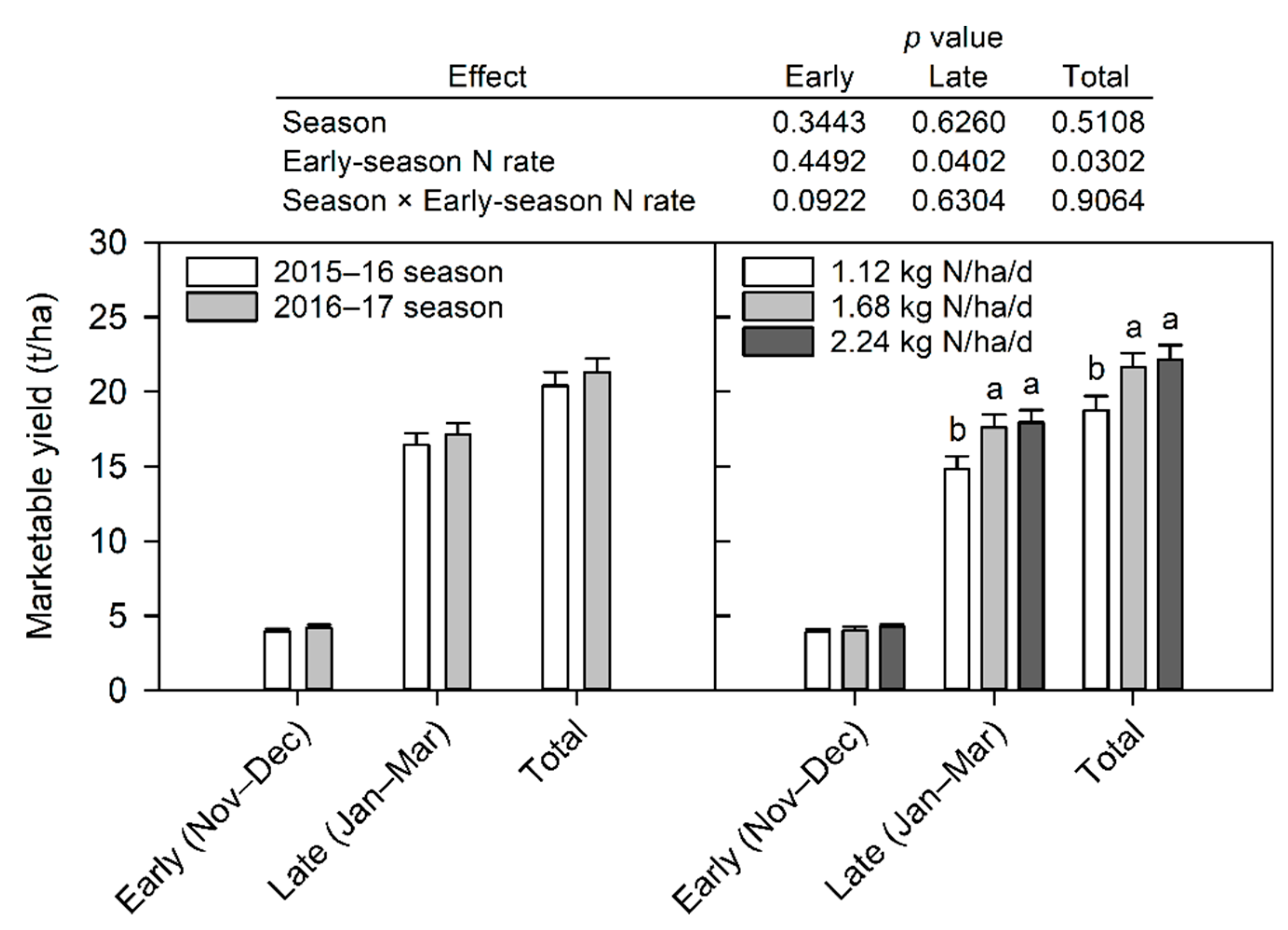
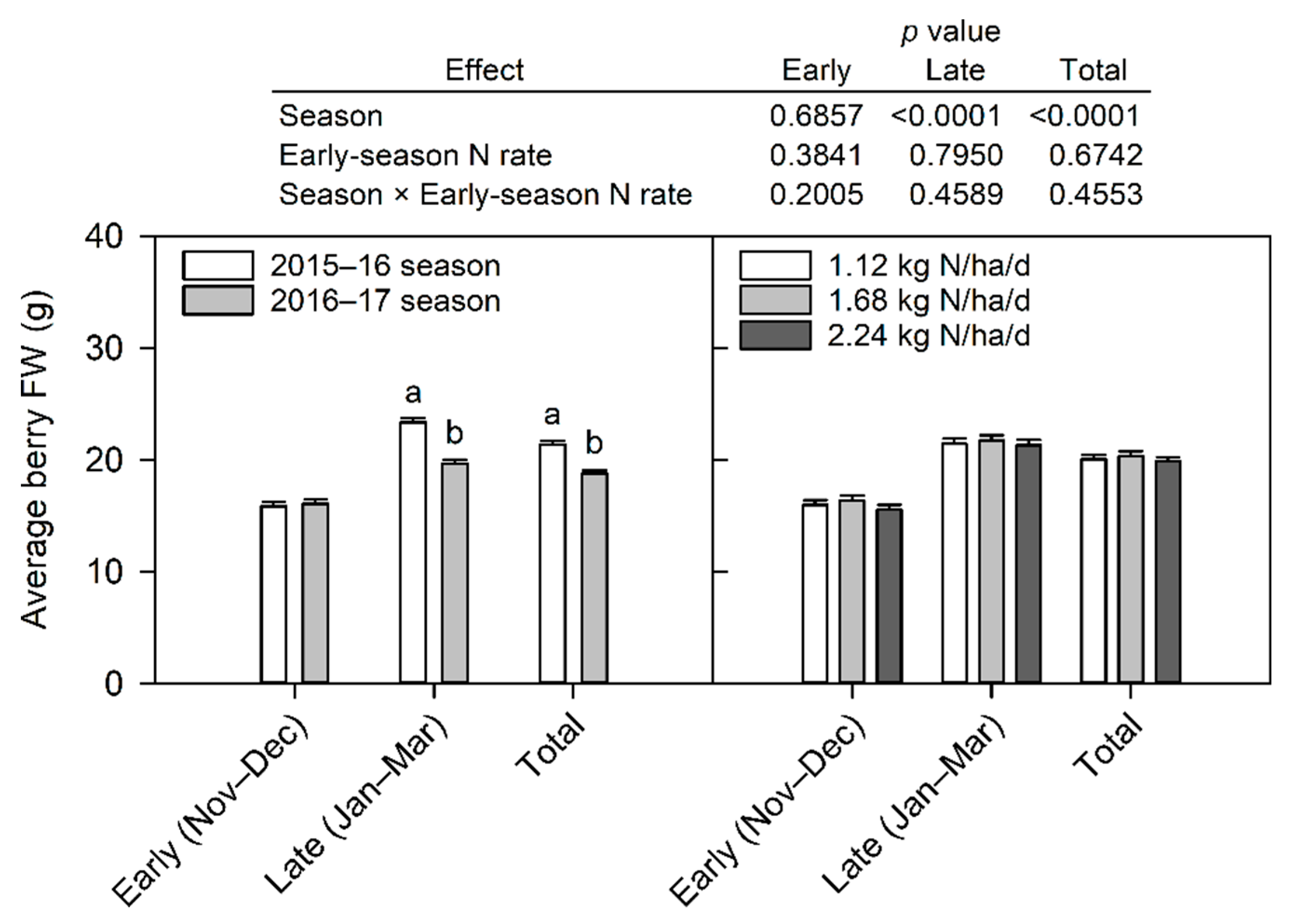
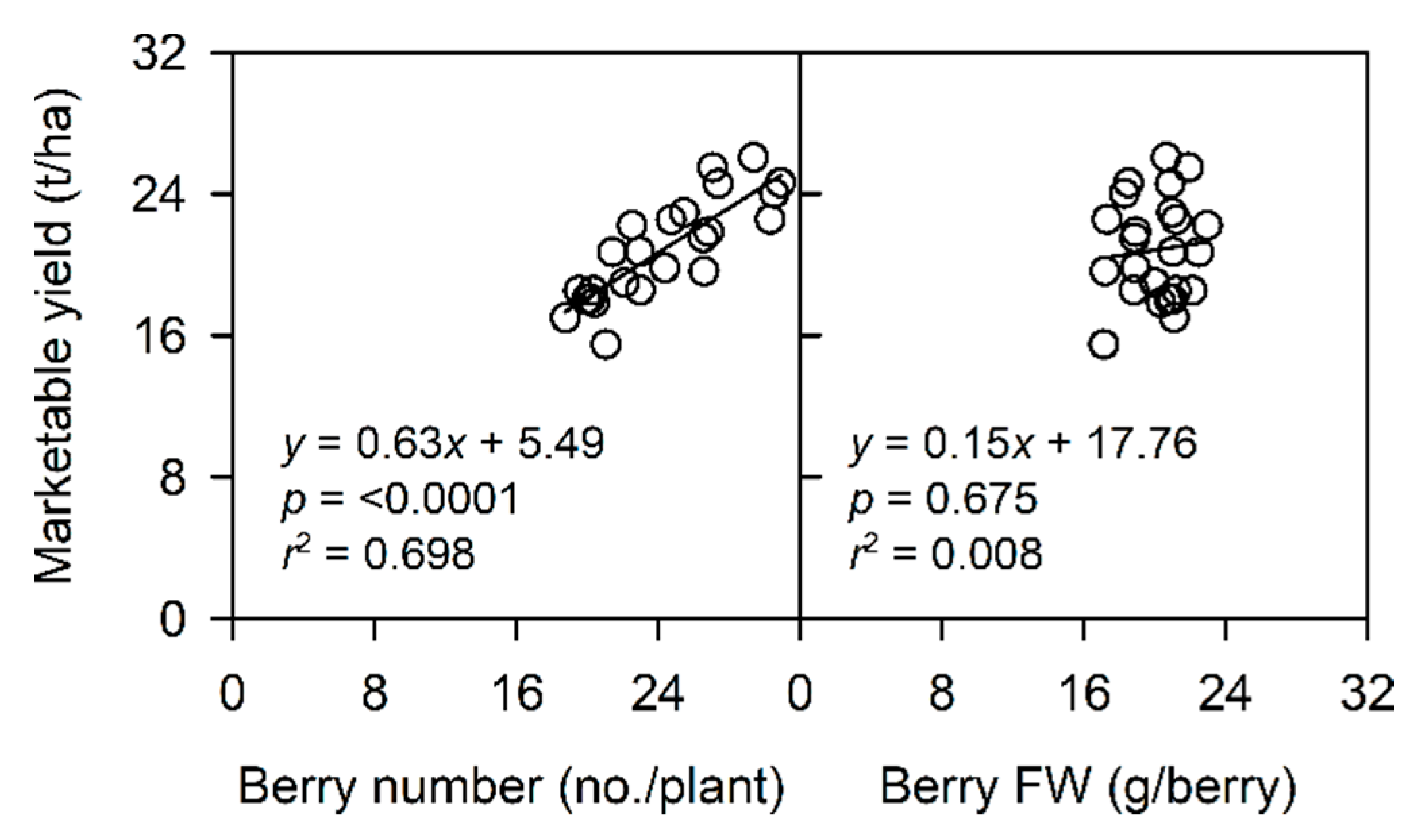
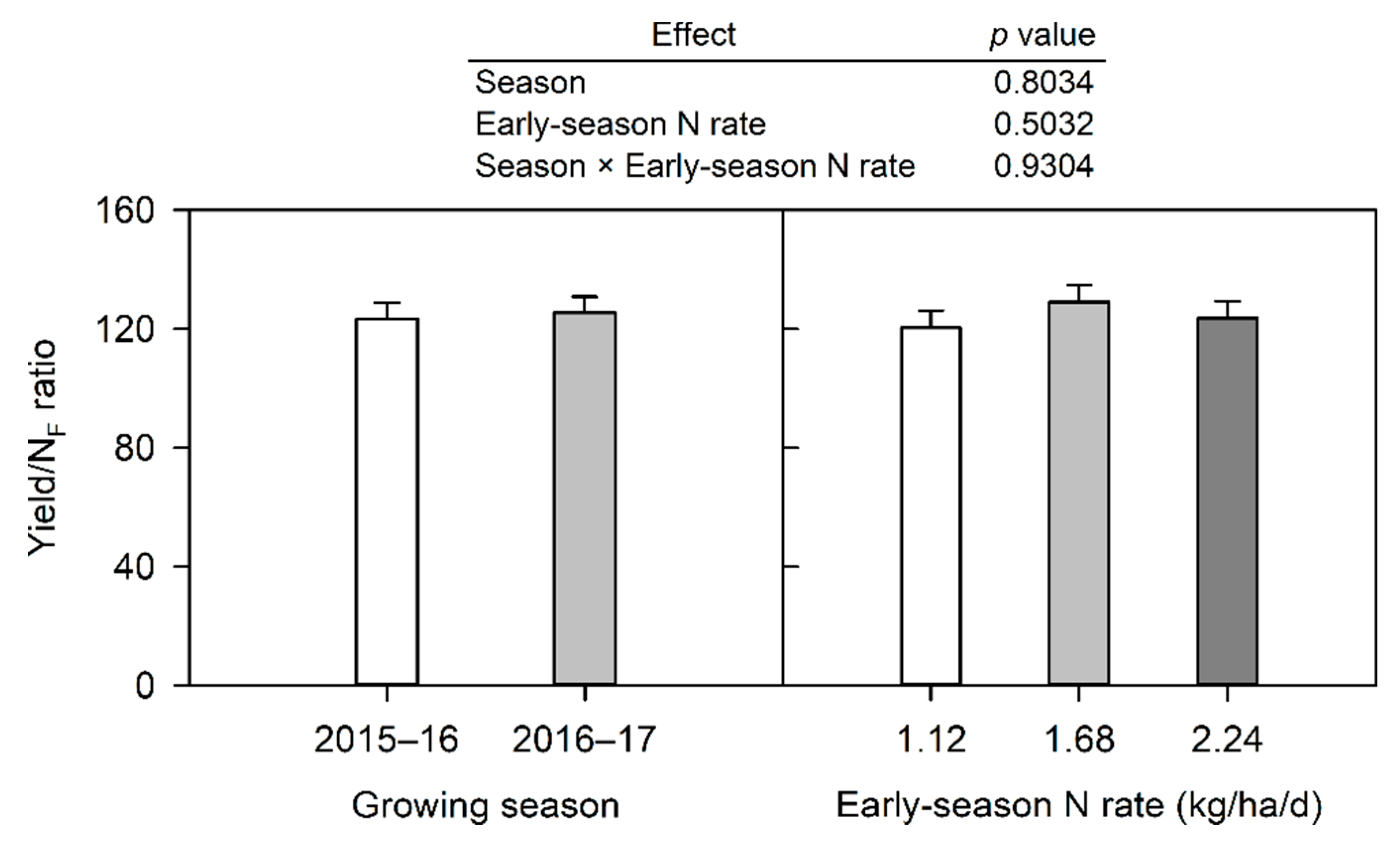
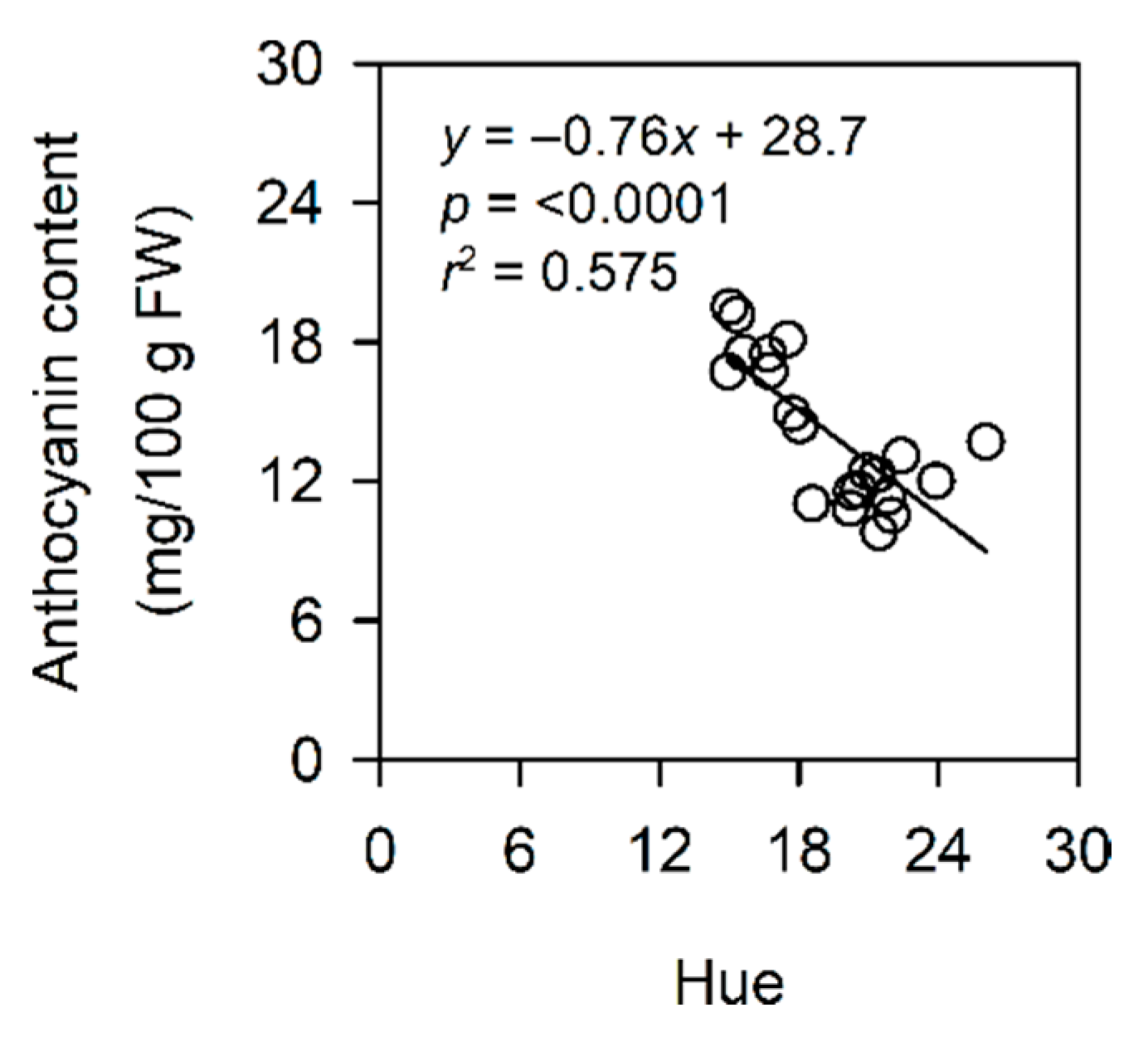
| Season | Treatment # | Early Season N Rate 1 | Mid–Late Season N Rate 2 | Total N Input | ||
|---|---|---|---|---|---|---|
| (kg/ha/d) | (kg/ha) | (kg/ha/d) | (kg/ha) | (kg/ha) | ||
| 2015–2016 | 1 | 1.12 | 23.5 | 1.12 | 130.0 | 153.6 |
| 2 | 1.68 | 35.3 | 1.12 | 130.0 | 165.3 | |
| 3 | 2.24 | 47.1 | 1.12 | 130.0 | 177.1 | |
| 2016–2017 | 1 | 1.12 | 23.5 | 1.12 | 134.5 | 158.0 |
| 2 | 1.68 | 35.3 | 1.12 | 134.5 | 169.8 | |
| 3 | 2.24 | 47.1 | 1.12 | 134.5 | 181.6 | |
| Season | Duration | Temperature (°C) | RH | SR | Rainfall | ||
|---|---|---|---|---|---|---|---|
| Max | Min | AVR | (%) | (W/m2) | (mm) | ||
| 2015–2016 | Entire season 2 | 25.2 | 13.8 | 19.0 | 79.7 | 148 | 325 |
| Fruit development 3 | 23.0 | 8.9 | 15.7 | 72.0 | 197 | 32 | |
| 2016–2017 | Entire season 4 | 26.2 | 13.6 | 19.4 | 78.4 | 151 | 95 |
| Fruit development 5 | 24.3 | 11.2 | 17.5 | 77.8 | 156 | 40 | |
| Season | Early-Season N Rate 2 | Color | Texture 3 | ||||||||
|---|---|---|---|---|---|---|---|---|---|---|---|
| (kg/ha/d) | L* | a* | b* | Chroma | Hue | (N) | |||||
| 2015–2016 | 38.0 | 24.1 | b | 7.4 | b | 25.4 | b | 16.4 | b | 4.40 | |
| 2016–2017 | 38.9 | 27.5 | a | 11.1 | a | 29.8 | a | 21.6 | a | 4.42 | |
| 1.12 | 38.1 | 26.0 | 9.3 | 27.7 | 18.9 | 4.49 | |||||
| 1.68 | 38.5 | 25.6 | 9.0 | 27.3 | 18.8 | 4.32 | |||||
| 2.24 | 39.0 | 26.7 | 10.5 | 28.8 | 20.6 | 4.43 | |||||
| p value | |||||||||||
| Season | 0.0847 | 0.0005 | <0.0001 | 0.0002 | <0.0001 | 0.9719 | |||||
| Early-season N rate | 0.5722 | 0.9257 | 0.7132 | 0.8711 | 0.5725 | 0.7898 | |||||
| Season × Early-season N rate | 0.5718 | 0.5668 | 0.2290 | 0.4910 | 0.0887 | 0.0217 | |||||
| Season | Early-Season N Rate 2 | pH | TA | SSC | SSC/TA | Anthocyanins | Phenolics | |||||
|---|---|---|---|---|---|---|---|---|---|---|---|---|
| (kg/ha/d) | (%) | (%) | (mg/100 g FW) | (mg/100 g FW) | ||||||||
| 2015–2016 | 3.51 | b | 0.649 | b | 5.69 | b | 8.78 | a | 17.2 | a | 180 | |
| 2016–2017 | 3.58 | a | 0.864 | a | 6.32 | a | 7.36 | b | 11.7 | b | NA | |
| 1.12 | 3.54 | 0.768 | 6.08 | 8.01 | 14.7 | 185 | ||||||
| 1.68 | 3.54 | 0.758 | 5.87 | 7.88 | 13.9 | 175 | ||||||
| 2.24 | 3.59 | 0.795 | 6.27 | 8.04 | 13.4 | 184 | ||||||
| p value | ||||||||||||
| Season | 0.0238 | <0.0001 | <0.0001 | <0.0001 | <0.0001 | NA | ||||||
| Early-season N rate | 0.7292 | 0.9963 | 0.1345 | 0.4706 | 0.1704 | 0.3955 | ||||||
| Season × Early-season N rate | 0.0579 | 0.5703 | 0.7763 | 0.7398 | 0.2393 | NA | ||||||
Publisher’s Note: MDPI stays neutral with regard to jurisdictional claims in published maps and institutional affiliations. |
© 2021 by the authors. Licensee MDPI, Basel, Switzerland. This article is an open access article distributed under the terms and conditions of the Creative Commons Attribution (CC BY) license (https://creativecommons.org/licenses/by/4.0/).
Share and Cite
Agehara, S.; Nunes, M.C.d.N. Season and Nitrogen Fertilization Effects on Yield and Physicochemical Attributes of Strawberry under Subtropical Climate Conditions. Agronomy 2021, 11, 1391. https://doi.org/10.3390/agronomy11071391
Agehara S, Nunes MCdN. Season and Nitrogen Fertilization Effects on Yield and Physicochemical Attributes of Strawberry under Subtropical Climate Conditions. Agronomy. 2021; 11(7):1391. https://doi.org/10.3390/agronomy11071391
Chicago/Turabian StyleAgehara, Shinsuke, and Maria Cecilia do Nascimento Nunes. 2021. "Season and Nitrogen Fertilization Effects on Yield and Physicochemical Attributes of Strawberry under Subtropical Climate Conditions" Agronomy 11, no. 7: 1391. https://doi.org/10.3390/agronomy11071391
APA StyleAgehara, S., & Nunes, M. C. d. N. (2021). Season and Nitrogen Fertilization Effects on Yield and Physicochemical Attributes of Strawberry under Subtropical Climate Conditions. Agronomy, 11(7), 1391. https://doi.org/10.3390/agronomy11071391







